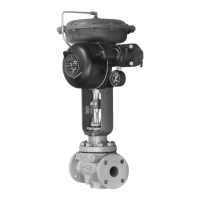Instruction Manual
D200108X012
546 Transducer
March 2015
3
Table 1. Specifications (continued)
Approximate Weight
4.1 kg (9 pounds)
Declaration of SEP
Fisher Controls International LLC declares this
product to be in compliance with Article 3 paragraph
3 of the Pressure Equipment Directive (PED) 97 / 23 /
EC. It was designed and manufactured in accordance
with Sound Engineering Practice (SEP) and cannot
bear the CE marking related to PED compliance.
However, the product may bear the CE marking to
indicate compliance with other applicable European
Community Directives.
NOTE: Specialized instrument terms are defined in ANSI/ISA Standard 51.1 - Process Instrument Terminology.
1. The pressure/temperature limits in this document and any applicable standard or code limitation should not be exceeded.
2. Normal m
3
/hr—Normal cubic meters per hour (0_C and 1.01325 bar absolute). Scfh—Standard cubic feet per hour (60_F and 14.7 psia).
3. Performance values are obtained using a 546 transducer with a 4 to 20 mA DC input signal and a 0.2 to 1 bar (3 to 15 psig) or a 0.4 to 2 bar (6 to 30 psig) output signal.
Ambient temperature is 24_C (73_F). A transducer with other input or output signals might exceed these values. Reference accuracies of ±3.5% can be expected with output ranges
starting near zero psig.
Table 2. Electromagnetic Immunity Performance
Port Phenomenon Basic Standard Test Level Performance Criteria
(1)
Enclosure
Electrostatic discharge (ESD) IEC 61000‐4‐2
4 kV contact
8 kV air
A
Radiated EM field IEC 61000‐4‐3
80 to 1000 MHz @ 10V/m with 1
kHz AM at 80%
A
Rated power frequency magnetic field IEC 61000‐4‐8 60 A/m at 50 Hz A
I/O signal/control
Burst (fast transients) IEC 61000‐4‐4 1 kV A
Surge IEC 61000‐4‐5 1 kV (line to ground only, each) B
Conducted RF IEC 61000‐4‐6
150 kHz to 80 MHz at 3 Vrms with
1kHz AM at 80%
A
Specification limit = ±1% of span
1. A=No degradation during testing. B = Temporary degradation during testing, but is self‐recovering.
Table 3. Hazardous Area Classifications—CSA (Canada)
Certification Body Certification Obtained Entity Rating Temperature Code Enclosure Rating
CSA
Explosion Proof
Class I, Division 1, Group C,D
- - - T5 (Tamb = 66_C) CSA ENC 3
Class II, Division 1, Groups E,F,G
Class I, Division 2, Groups A,B,C,D
Class II, Division 2, Groups F,G
- - - T5 CSA ENC 3
Table 4. Hazardous Area Classifications—FM (United States)
Certification Body Certification Obtained Entity Rating Temperature Code Enclosure Rating
FM
Explosion Proof
Class I, Division 1, Groups C,D
- - - T5 (Tamb = 60_C) NEMA 3R
Class II, Division 1, Groups E,F,G
Class I, Division 2, Groups A,B,C,D
Class II, Division 2, Groups F,G
- - - T5 NEMA 3R
Description
The 546 transducer (figure 1) receives either a voltage (VDC) or a current (mA DC) input signal and transmits a
proportional pneumatic output pressure to a final control element. A typical application is in electronic control loops
where the final control element, generally a control valve, is pneumatically operated. The input signal and output
pressure range of each transducer is indicated on the nameplate attached to the cover, as shown in figure 2.

